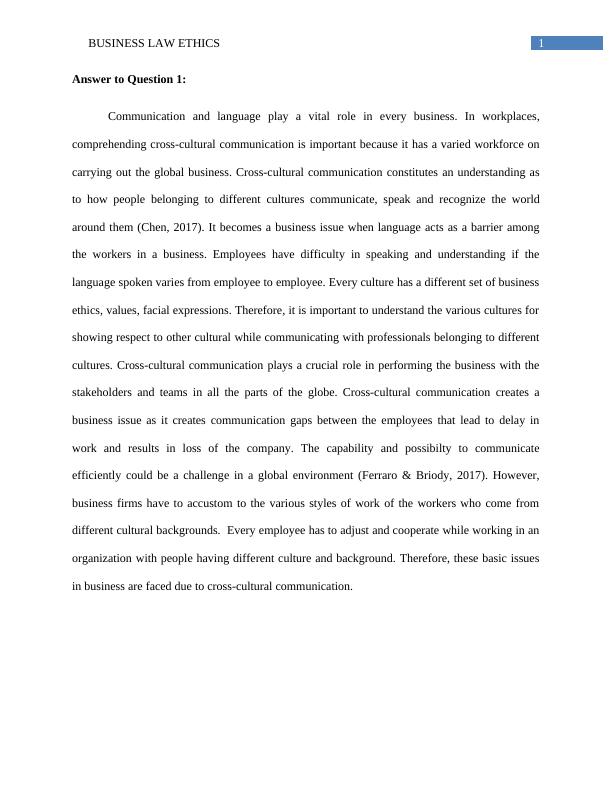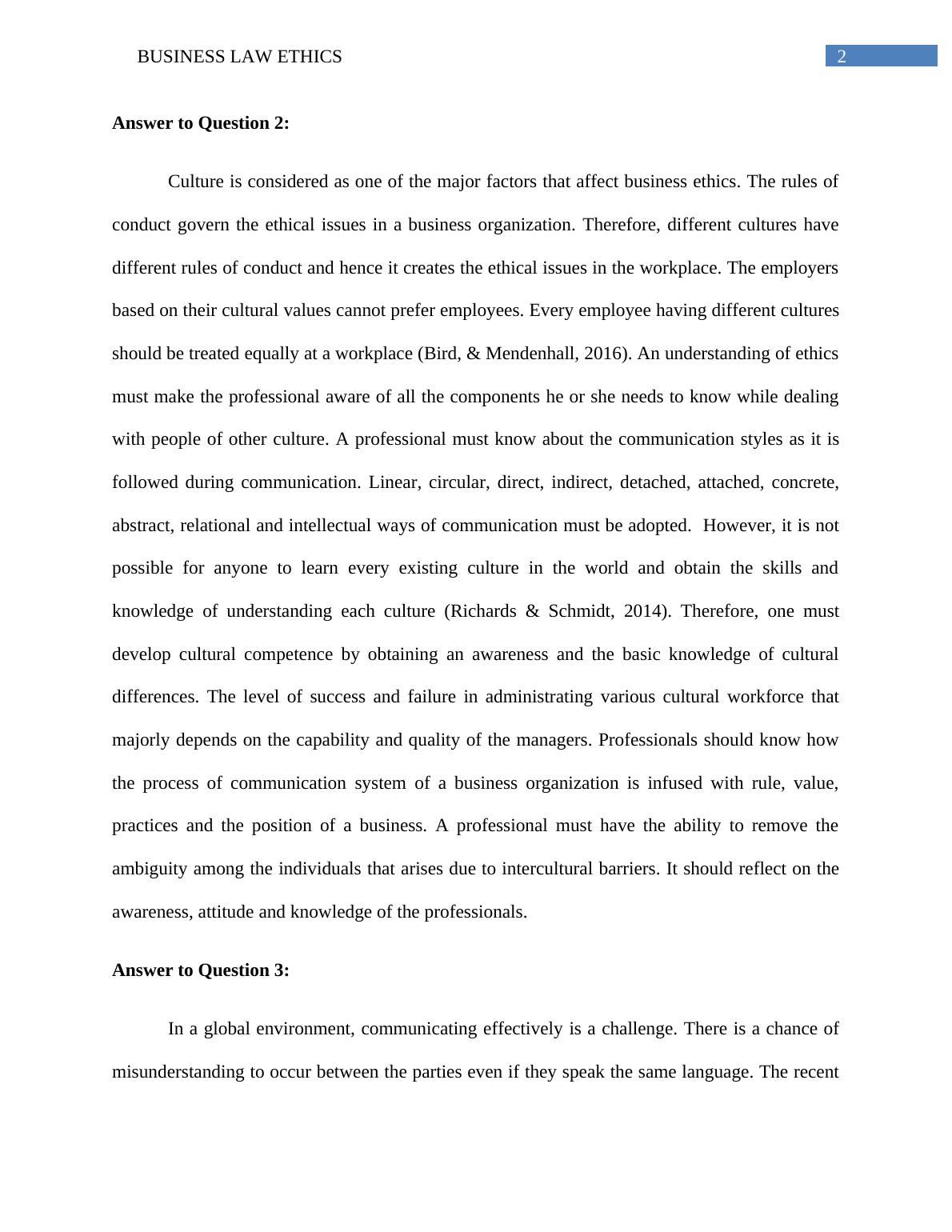Cross-Cultural Communication in Workplaces
Added on 2020-05-28
13 Pages3636 Words471 Views
Running head: BUSINESS ETHICSBusiness EthicsName of the StudentName of the UniversityAuthor note

1BUSINESS LAW ETHICSAnswer to Question 1:Communication and language play a vital role in every business. In workplaces,comprehending cross-cultural communication is important because it has a varied workforce oncarrying out the global business. Cross-cultural communication constitutes an understanding asto how people belonging to different cultures communicate, speak and recognize the worldaround them (Chen, 2017). It becomes a business issue when language acts as a barrier amongthe workers in a business. Employees have difficulty in speaking and understanding if thelanguage spoken varies from employee to employee. Every culture has a different set of businessethics, values, facial expressions. Therefore, it is important to understand the various cultures forshowing respect to other cultural while communicating with professionals belonging to differentcultures. Cross-cultural communication plays a crucial role in performing the business with thestakeholders and teams in all the parts of the globe. Cross-cultural communication creates abusiness issue as it creates communication gaps between the employees that lead to delay inwork and results in loss of the company. The capability and possibilty to communicateefficiently could be a challenge in a global environment (Ferraro & Briody, 2017). However,business firms have to accustom to the various styles of work of the workers who come fromdifferent cultural backgrounds. Every employee has to adjust and cooperate while working in anorganization with people having different culture and background. Therefore, these basic issuesin business are faced due to cross-cultural communication.

2BUSINESS LAW ETHICSAnswer to Question 2:Culture is considered as one of the major factors that affect business ethics. The rules ofconduct govern the ethical issues in a business organization. Therefore, different cultures havedifferent rules of conduct and hence it creates the ethical issues in the workplace. The employersbased on their cultural values cannot prefer employees. Every employee having different culturesshould be treated equally at a workplace (Bird, & Mendenhall, 2016). An understanding of ethicsmust make the professional aware of all the components he or she needs to know while dealingwith people of other culture. A professional must know about the communication styles as it isfollowed during communication. Linear, circular, direct, indirect, detached, attached, concrete,abstract, relational and intellectual ways of communication must be adopted. However, it is notpossible for anyone to learn every existing culture in the world and obtain the skills andknowledge of understanding each culture (Richards & Schmidt, 2014). Therefore, one mustdevelop cultural competence by obtaining an awareness and the basic knowledge of culturaldifferences. The level of success and failure in administrating various cultural workforce thatmajorly depends on the capability and quality of the managers. Professionals should know howthe process of communication system of a business organization is infused with rule, value,practices and the position of a business. A professional must have the ability to remove theambiguity among the individuals that arises due to intercultural barriers. It should reflect on theawareness, attitude and knowledge of the professionals. Answer to Question 3:In a global environment, communicating effectively is a challenge. There is a chance ofmisunderstanding to occur between the parties even if they speak the same language. The recent

3BUSINESS LAW ETHICSeconomic challenges that are faced in an organization are negative low growth, raisingunemployment and raising inflation. Such challenges are faced due to interculturalcommunication (Moran, Abramson & Moran, 2014). Therefore, it results in a bad goodwill ofthe company. Many companies did not strike the favorable opportunities during the economiccrisis. Instead, the companies challenged with a duty trying to save the companies from sinking.Although the challenges kept the employees motivated at the workplace. Hence, developmentsshould be made in the organization to reduce the level of threats and challenges. Internalchallenges in an organization can be reduced by decreasing the level of cross-culturalcommunication. The management style and understanding the employees is important as the riftsusually arises between the employees because of cross-cultural communication (French, 2015).The non-verbal code system of a culture is different from one’s own is definitely helpful and informing a relationship of communication within intercultural context. If the communication doesnot take place verbally, then a textual conversation can make the process of communicationeasier. Therefore, if the barriers of cross-cultural communication are removed and the challengesare met, there will not be any issues related to it. The barriers of communication usually arisebecause of the lack of understanding between the parties. The system of communication in aMNC will evidently have to tackle certain restraints because of the difference of the managementof the work. Therefore, it is essential to conquer the differences in a cross-culturalcommunication since a theory can be formed through an efficient communication system in anMNC. Answer to Question 4:Cultural proficiency does not mean remembering and having knowledge of every culturalnuance of every market. It means when should one listen, when to ask for help and when is the

End of preview
Want to access all the pages? Upload your documents or become a member.
Related Documents
A Global Perspective of Ethics in Businesslg...
|16
|3807
|42
Business Ethics Assignment- Cross Cultural Communicationlg...
|17
|4209
|244
Business Ethics in Global Perspectivelg...
|12
|3110
|276
Managing Across Culture: Importance of Hofstede's Cultural Dimensionlg...
|7
|2283
|148
The Communication and Technologylg...
|7
|1451
|14
Workplace Communications Systemlg...
|6
|1017
|85
